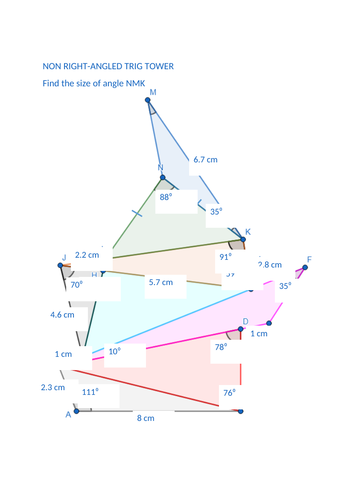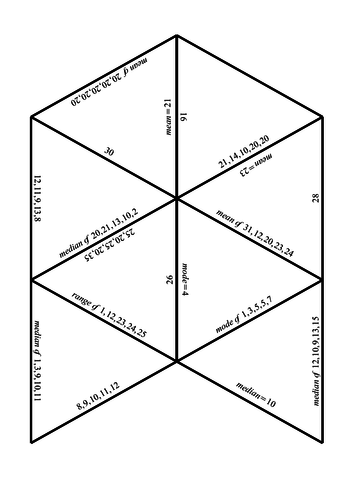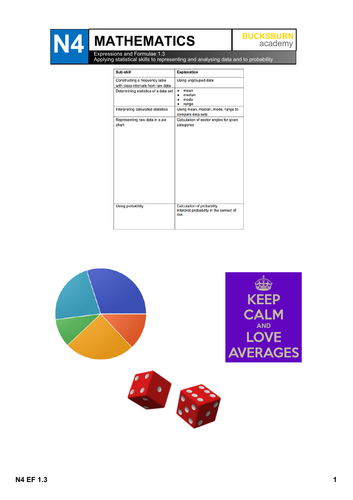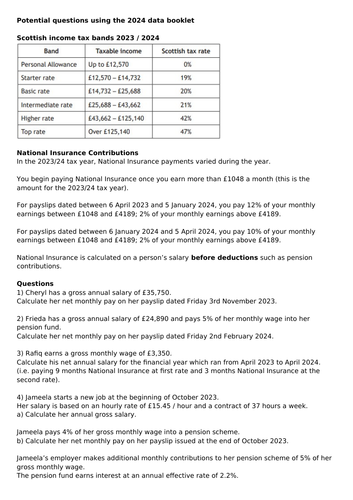
55Uploads
32k+Views
24k+Downloads
All resources

Sine and Cosine rule trigonometry pile up
Work from the bottom to get an answer at the top!
No “ambiguoius” cases (where you need to use sin(x)=sin(180-x)).
Solutions will be uploaded eventually!

Angle of elevation / scale drawing worksheet
Six questions asking pupils to find the real heights of objects by using the given angle of elevation and a given scale to construct scale diagrams.
The first three questions use simple scales of 1: a single digit. The second three use scales which are multiples of 10.
Instructions could be edited to instruct pupils to use right angled Trigonometry instead.

Optimization - scaffolded problems
Something pupils traditionally find difficult. All context stripped away and problems laid out in a structured grid. Handwritten solutions included.

Increasingly Difficult Exercise: Equation of a Cirlce (SQA Higher Maths)
An set of questions that gets increasingly difficult with each subsequent question. Covers course content for SQA (Scottish) Higher. This task was uploaded to Chris McGrane’s starting points website a few years back. I’ve uploaded it here with a handwritten set of solutions.

Averages and range jigsaw
Puzzle calculating mean, median, mode and range.
Some questions tell pupil what average to find (eg “mean of 20, 20, 10, 14, 16” matches up with the card “16”) where as some just give the list and pupils have to find all averages and range before matching up (eg “12,11,9,13,8” matches up with “median = 11”).
No repeated answers so there should only be one unique solution.
PDF of file included for those without the Tarsia software, original Tasia file included for those that want to edit the file.

Solving Trigonometric Equations With Graphs
First handful of questions have pupils solving trigonometric equations by sketching graphs to identify which quadrants solutions lie in and using the symmetry of said graphs to find the value of these solutions. The second half of the task changes the problems to have pupils working back from a graph or solution to create the equations for themselves.
EDIT: There are a couple of errors on the last page of the answer file.

Multiplying and dividing fractions using grids
Rather than teaching pupils the shortcut/algorithms for fraction multiplication and division these worksheets aim to get pupils to understand what is actually happening when you perform the operations.

National 4 (N4) Mathematics: Relationships 1.1, 1.2, 1.3, 1.4 pupil notes
Smartboard files for use on an interactive whiteboard. PDF versions of the same file for printing as booklets and issuing to pupils. Notes contain examples for teachers to go over on the board and some tasks for pupils to do. Questions and examples have been sourced from various resources so make sure you're not issuing the same task twice! At the end of these there are also revision questions and a checklist for pupils to "traffic light" their learning.
DISCLAIMER: There are most likely errors in here as I'm bad at proof reading my materials so read and check over before using!

Space Invaders and Tetris scale enlargement
Excel spreadsheet featuring pictures of Space Invaders and Tetris blocks. These can be printed or displayed on the board for pupils to enlarge.
The Space Invaders are trickier given their "fiddly" nature or their arms and legs and the Tetris blocks are more straight forward.
The Tetris block sheet has a challenge to use a scale factor of 1/2.

National 5 (N5) Mathematics Circle Geometry
Smartboard files for use on an interactive whiteboard. PDF versions of the same file for printing as booklets and issuing to pupils. Notes contain examples for teachers to go over on the board and some tasks for pupils to do. There are past exam questions at the end of the booklet. Questions and examples have been sourced from various resources so make sure you're not issuing the same task twice! Page numbers on the cover refer to the R3 Scottish Secondary Mathematics textbook.
I made some "fliupped learning" videos for these notes. They can be found here: https://www.youtube.com/playlist?list=PLcTPEkVfYHu_Q5jwEihq7XLIhPzaBRP47
DISCLAIMER: There are most likely errors in here as I'm bad at proof reading my materials so read and check over before using!

National 4 (N4) Mathematics: Expressions and Formulae 1.1, 1.2, 1.3 pupil notes
Smartboard files for use on an interactive whiteboard. PDF versions of the same file for printing as booklets and issuing to pupils. Notes contain examples for teachers to go over on the board and some tasks for pupils to do. Questions and examples have been sourced from various resources so make sure you’re not issuing the same task twice! At the end of these there are also revision questions and a checklist for pupils to “traffic light” their learning.
DISCLAIMER: There are most likely errors in here as I’m bad at proof reading my materials so read and check over before using!

Higher Applications of Maths - varying National Insurance rates
A handful of questions based on the National Insurance rates given in the 2024 data booklet.

National 5 (N5) Mathematics Vectors
Smartboard files for use on an interactive whiteboard. PDF versions of the same file for printing as booklets and issuing to pupils. Notes contain examples for teachers to go over on the board and some tasks for pupils to do. There are past exam questions at the end of the booklet. Questions and examples have been sourced from various resources so make sure you're not issuing the same task twice! Notes have been deisgned to follow the order of the Leckie and Leckie N5 textbook.
DISCLAIMER: There are most likely errors in here as I'm bad at proof reading my materials so read and check over before using!

Product sum bricks
Pre-requisit for quadratic factorising - considering the sum and product of two terms. This task looks at integers and algebraic terms (with some extension into factorising). It’s in three levels - it’s designed for pupils to pick their own level rather than working through all the sections.

Translating with vectors SPACE INVADERS
Using column vectors to move blocks around to create Space Invaders. Four problems in total - each one is a little bit more complicated than the one before it.
The worksheet should be free from errors but I’ve uploaded it as an editable Word file just in case! A scan of my solutions is also included.

Statistical significance - t-test: Higher Applications of Maths
Worksheet and datasets for performing paired and independent t-tests on.
All bar one of the datasets are based on real life sources.

Correlation and causation: Higher Applications of Maths
A task which involves generating scatterplots and correlation coefficients using nutritional information from a McDonalds menu.
Worksheet and csv dataset.
Points of interest:
Menu is from America leading to a discussion about how useful is it for use in UK
High number of breakfast items and low number of burgers doesn’t reflect common perception of McD’s menu
Sodium (ie salt) and calories have a strong correlation but this is a spurious relationship (salt has no calories) with portion size being a possible confounding variable

Calculating mean and range
Worksheet on mean and range.
Pupils use dice to generate data.
First sheet involves dividing by 5 and 4 so may end up with decimal answers.
Second sheet can be used as extension / discussion point as it involves dividing by 6 which may result in a reoccurring decimal.

Pearson correlation coefficient tasks: Higher Applications of Maths
Two tasks:
One calculating the Pearson correlation coefficient by hand. A right pain in the backside and shows why we use computers to do such a thing (worth noting doing this by hand is something that could be assessed if doing Level 6 Numeracy).
One getting pupils used to coding the correlation coefficient using statistical software (using the attached csv dataset) and seeing what it means in terms of the regression line without context getting in the way.

Statistical significance - z-test: Higher Applications of Maths
Excuse the emotional whiplash of going from heights of sportsmen to the biggest maritime disasters in history but a few questions on performing z-tests. Includes a dataset to draw figures from for the sportmen question.




















